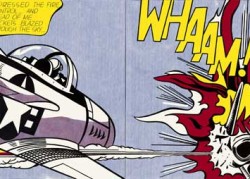This is the first full-scale retrospective since the last held in Guggenheim New York four years before his death in 1997. It travelled from Chicago to Washington DC and now landing in London where it will stay at the Tate Modern until de 27th of May before it moves to Paris for its final stop. Carrying with it a comprehensive ouvre presented through an impressive curatorial narrative that raises this iconic artist, generally well known, to widespread his place as a relevant figure in art history.
The exhibition opens with a “pop”, an optical illusion effect created by the Benday dots – the characteristic dots that permeated most of his paintings, almost like pores – opening the eyes to adjust to Lichtenstein’s world. His body of works come to life with the information provided to the visitor and by each room that follows, all to fortify the curatorial statement that Lichtenstein was an artist conscious of his referential work about art itself and its place in art history.
Lichtenstein created a radical new style for his time and was father to many key practices of contemporary art, like appropriation, citation and the exploration of popular visual culture, along many others. He used predetermined conventions to question and change the way high cult was seen. By examining art he also interrogated, represented and put into focus the society of this time. Because, after all, that’s what art is all about.
The first room holds his Brushstroke paintings, created around 1965, where he challenged the idea of authorship and originality. By reproducing the marks present in Abstract Expressionism he was taking all emotionality from it because it is not the brushstroke itself but a representation of one. The gesture of the painter is jeopardized because even with its mechanical aspect it was still painted by hand.
Being face to face with Lichtenstein’s paintings is a whole different experience from seeing reproductions of it, as paradoxical as this may seem. Because you can actually see the imperfections caused by marks done by his hand, the outmost portrayal of the man vs machine discussion. His technique is already a symbol of what he wanted to represent about society.
His works lay in a metaphorical sphere in so many different levels. Commenting, appropriating and parodying society and art itself, making high cult be criticized and understood at the same time, approximating it to popular culture. Look Mickey (1961), presented in the second room, is considered his first Pop Art painting. A metaphor is present in the dialogue bubble: “I’ve hooked a big one”, meaning that he had fulfilled his target. This room also presents paintings where he represented women’s role in society, such as in The Ring (1962) and Spray (1962) bringing up feminist issues. With Sponge (1962) he refers metaphorically to the idea of erasing a painting. Very well advanced by the curatorial narrative.
Room 3 brings a change from his vivid colours to a black and white palette to focus on the objects represented, some filling the entire canvas to become the object itself, a technique later used by Warhol in Brillo Box. His Campbell’s Soup Can (1962) also owe a lot to Lichtenstein, since copying was a common practice in this environment. This room also shows Magnifying Lens (1963) that carries a metaphorical aspect of looking closely to his technique and correspondingly to society itself.
When Leo Castelli became his NY dealer, in 1961, Lichtenstein had already established his position and style in the art world and began working with narrative themes such as war and romance. He wanted to explore archetypes, like in classical art, so he borrowed from comic books the clichés that made him so famous. When Lichtenstein created Masterpiece (1962) he was really fixing his place in art history as an artist in search of “the underlying principle of art”, as he says. He wanted to grasp what made some works of art valuable and others valueless.
Settling on the border between popular and fine art his paintings are like the comics he used to copy, they lay between one frame of art and the other, and that is how he positions himself in art history. He reframed everything under his unique and particular style to make people see the culture around them, and that’s what made him so influential. His production was so powerful that turned him into the subject he worked with, it turned him into an icon.



